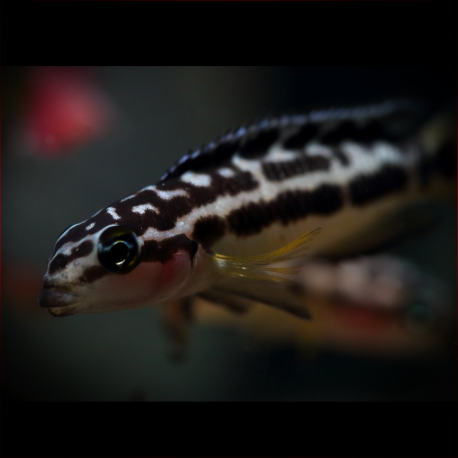More info
Datasheet
| Minimum Tank Size | 70 litres / 18.49 US gallons |
| Maximum Size | 8.0cm / 3.15inches |
| Temperature | 23°C / 73.40°F - 27°C / 80.60°F |
| Hardness | 10-25ºdH |
| pH | 7.5-9.0 |
General Description
The Julidochromis Ornatus, also known as the "Golden Julie," is a common cichlid species from Lake Tanganyika. It is part of the Cichlidae family, reaching a maximum size of 8.0cm. Tank-bred specimens may not display the vibrant colors of wild individuals, and care should be taken to avoid large water changes that could disrupt pair bonds.
Aquarium Setup
For optimal care, Julidochromis Ornatus should be placed in a Lake Tanganyika biotope aquarium with plenty of rocks arranged to create caves throughout the tank. A sandy substrate is preferred, and water conditions should mimic Lake Tanganyika, with a pH of 7.5-9.0, temperature between 23-27°C, and hardness of 10-25°dH (see table).
Behaviour
These cichlids are territorial and should be kept in pairs, as they can display aggression towards conspecifics. They can coexist with other small to medium-sized Tanganyikan cichlids that occupy different tank areas, such as Neolamprologus shelldwellers. Larger aquariums are necessary if keeping multiple Julidochromis Ornatus.
Feeding and Diet
The diet of Julidochromis Ornatus should consist mainly of live and frozen foods, with dried foods given less frequently. Supplementing with vegetable matter like spirulina or blanched spinach is also recommended for their nutrition.
Reproduction & Dimorphism
Reproduction for Julidochromis Ornatus is relatively easy but requires patience. They are bi-parental cave spawners, with pairs forming naturally over time. The female lays eggs in caves, with the male guarding the area. Fry should be fed brine shrimp nauplii, and care should be taken to remove them once they reach around 1".
Habitat and Distribution
In their natural habitat, Julidochromis Ornatus occupies rocky areas in the intermediate zone between the shoreline and open water in Lake Tanganyika. While primarily found in the northern part of the lake, certain morphs can be located in the southern region around Mpulungu.

